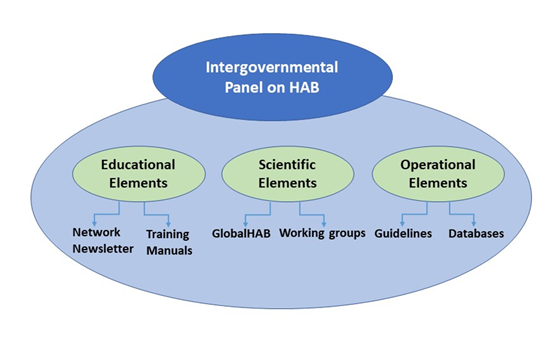ABOUT THE HARMFUL ALGAE BLOOM PROGRAM
HISTORY
The outline of an international programme was completed by a broad spectrum of experts at an IOC-SCOR workshop, Newport, USA, in November 1991. After revision by the newly established Intergovernmental Panel on Harmful Algae in June 1992, the Programme consisted of three main elements: A scientific element, an operational element, and an educational element. The Harmful Algal Bloom Programme Plan (Annex VII in this Report) was adopted by the Seventeenth Session of the IOC Assembly in 1993 as a part of IOC follow-up to UNCED Agenda 21, Chapter 17. Many IOC member States have confirmed the importance and urgency to adequately address the HAB problem. In 2009 IPHAB adopted a Strategy to strengthen implementation of the IOC HAB Programme.
The overall goal of the HAB Programme, as indicated below, embraces these three time scales as well as a range of related scientific and administrative problems:
To foster the effective management of, and scientific research on, harmful algal blooms in order to understand their causes, predict their occurrences, and mitigate their effects.
There are three major divisions: educational; scientific, and operational. The educational programme element can be separated into 2 branches: information networks; training and capacity building. The scientific programme element can be separated into 3 branches: ecology and oceanography; taxonomy and genetics; and toxicology and toxin chemistry. The operational programme element can be divided into 3 branches: resource protection; monitoring; and public health and seafood safety. There are many interactions between the subjects and actions, e.g., fisheries management questions benefit from knowledge of the ecology and dynamics of blooms; monitoring is based on ecological, oceanographic, taxonomic, and toxicological information.
HARMFUL ALGAE BLOOM PROGRAMME ELEMENTS AND GOALS:

EDUCATIONAL PROGRAMME ELEMENTS
Training: To promote and facilitate the development and implementation of appropriate training programmes in order to distribute the necessary knowledge and expertise on a global basis.
SCIENTIFIC PROGRAMME ELEMENTS
Ecology and Oceanography: To understand the population dynamics of harmful algae.
Taxonomy and Genetics: To establish the taxonomy and genetics of the causative organisms at the appropriate levels.
Toxicology and Toxin Chemistry: To determine the physiological and biochemical mechanisms responsible for toxin production and accumulation, and to evaluate the effect of phycotoxins on living organisms.
OPERATIONAL PROGRAMME ELEMENTS
Resource Protection: To develop and improve methods to minimize the environmental and economic consequences of harmful algae.
Monitoring: To promote and facilitate the development and implementation of appropriate monitoring programmes.
Public Health and Seafood Safety: To protect public health and ensure seafood quality
